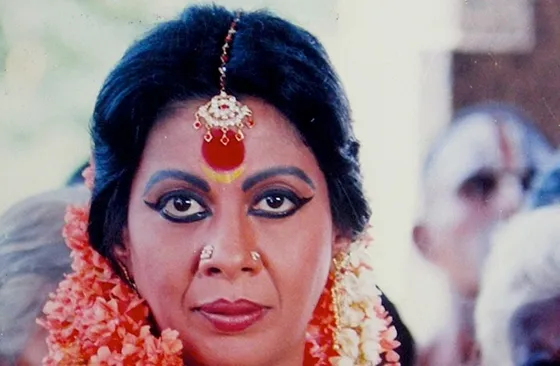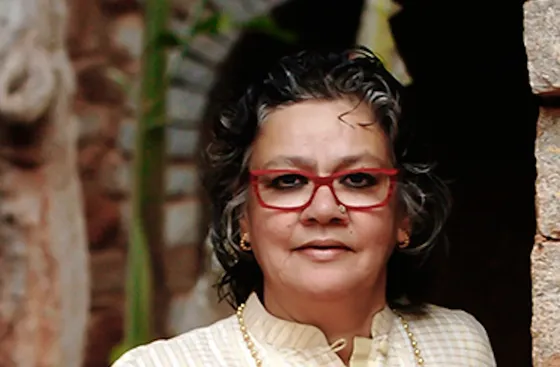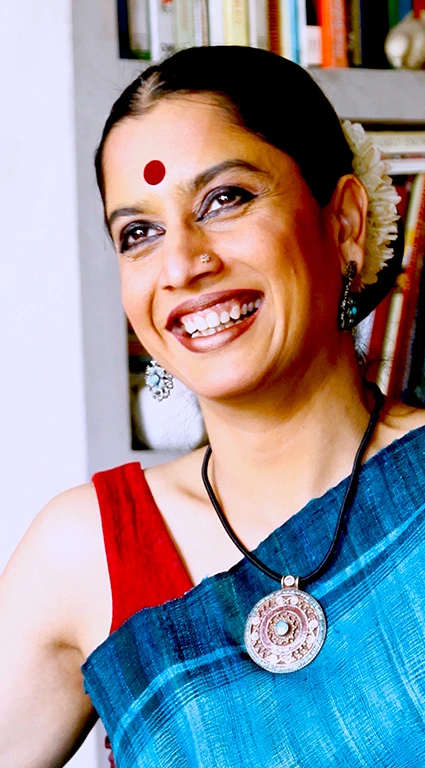gives pure movement
the heady feel
of casting
a mesmeric spell”
She walked through a wicker gate with bells on it and that changed her life. Surupa Sen had just finished a degree in Economics and came to Nrityagram, keen to learn Odissi, an art form she had fallen in love with. She thought she would learn for a few months, maybe a year, and she ended up making it her home for more than three decades now. But we get ahead of ourselves; let’s go back to the wicker gate.
As Surupa entered the wicker gate and stepped into the verdant environs of Nrityagram, she encountered a very large pair of eyes sizing her up. She met Protima Gauri for the first time, and walked around the campus with her, and was besotted, by both the idea of the place and the woman who had conjured it. Yet, she was unsure. She thought she would come for a short course, and the shortest course in Nrityagram spanned six years. Her friend who accompanied her put it in perspective - any professional course takes a minimum of that many years to master, so why should this be any different? Convinced, Surupa went back to Delhi, told her parents that she was off, and with a suitcase, bucket, running shoes, and a mosquito net, she came back to Nrityagram.
Those initial years were gruelling. The joke was that, if you had to learn discipline, you joined the army or Nrityagram. It was akin to bootcamp. With other students, she woke up at 5am, went for a run, then countless hours of practice, and the rest of the time spent helping around the campus that was still taking shape.
Surupa began her Odissi training with the architect of Odissi, Guru Kelucharan Mahapatra. She also learned Odissi with Guru Protima Gauri, Guru Ratikant Mahapatra and Guru Bichitranandan Swain. She studied Abhinaya with Guru Kalanidhi Narayanan and the Natyashastra under the supervision of Dr. Padma Subrahmanyam. She was the first student to graduate out of the Nrityagram programme.
Despite the gruelling schedule, Surupa says that, that’s when she felt she was completely focused - her dance, the art and craft were being honed, and that would be her lifelong pursuit. She started delving deep into the form, asking questions, seeking answers, and charting her own unique journey into the mysteries of Odissi.
How does a movement take birth? What is the impulse that leads to a specific kind of movement? Every single gesture, from the sway of a hip to the arc of a fingertip became the subject of her constant enquiry. As a dancer of contemporary times, whose arena was the proscenium stage, her dance and her choreography acquired layers that came out of her focus, that spanned not days, but decades. Her research expanded the dance vocabulary of Odissi, and developed an aesthetic style that became the hallmark of Nrityagram dance.
Even as a child, Surupa choreographed dances. From creating school dances to choreographing pieces that won national competitions, her genius in wielding time and space was evident early on.
In Indian classical dance, often, the focus is on the individual dancer, and not on the space occupied by the individual. Therefore, it helps to dwell awhile on what choreography means, as defined by Surupa - she wields time and space in a way that both bend to her will and submit. And choreography, the way Surupa does it, means working on the rhythm, music, and movement. She has worked closely with Pandit Raghunath Panigrahi since 1999, on original music compositions for her work, and the music she uses has a distinct emotive depth that is heightened by movement, so they fuse together into an organic whole.
Surupa has choreographed seven full-length Ensemble shows, two full-length duet shows, two full-length solo shows, and innumerable dance pieces that have enchanted audiences worldwide.
In June 2000, Surupa received a grant from The Asian Cultural Council, New York that allowed her to participate in the International Choreographers Residency at the American Dance Festival. She received the Raza Foundation Award in 2006, the Yagnaraman Award from Sri Krishna Gana Sabha, Chennai in 2008, the Nritya Choodamani from Sri Krishna Gana Sabha, Chennai in 2011 and the Sangeet Natak Akademi Award for Odissi Dance in 2018.
Through her dance Surupa Sen continues to seek the intangible - her journey, a beacon for those who pursue that elusive spirit in their lives.
“She was magnificent, especially in ‘Yami He’ which spoke of loneliness, in which she stood in a pool of red
light and radiated a profound stillness from the bones.”
The New York Times
“According to tradition, largely a solo form, Indian classical dance has succumbed to the ensemble but
rarely justified it. Nrityagram’s artistic director, however, transforms islands of activity into an
archipelago that stretches across the stage... Sen has writ large the romance between line and curve that
distinguishes Odissi!”
Financial Times, New York








